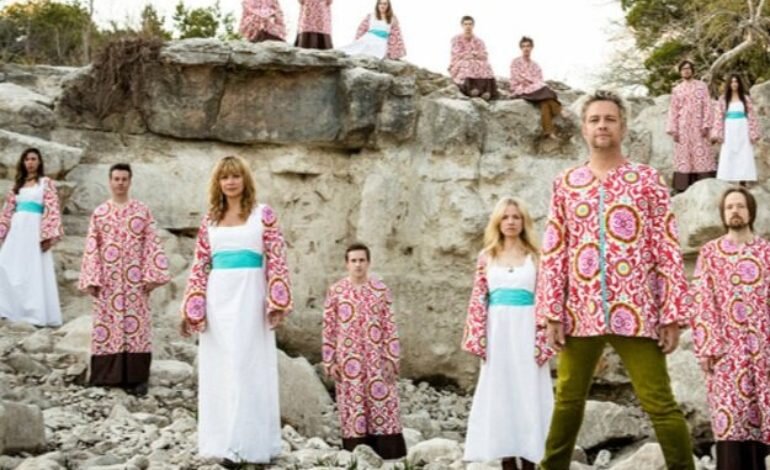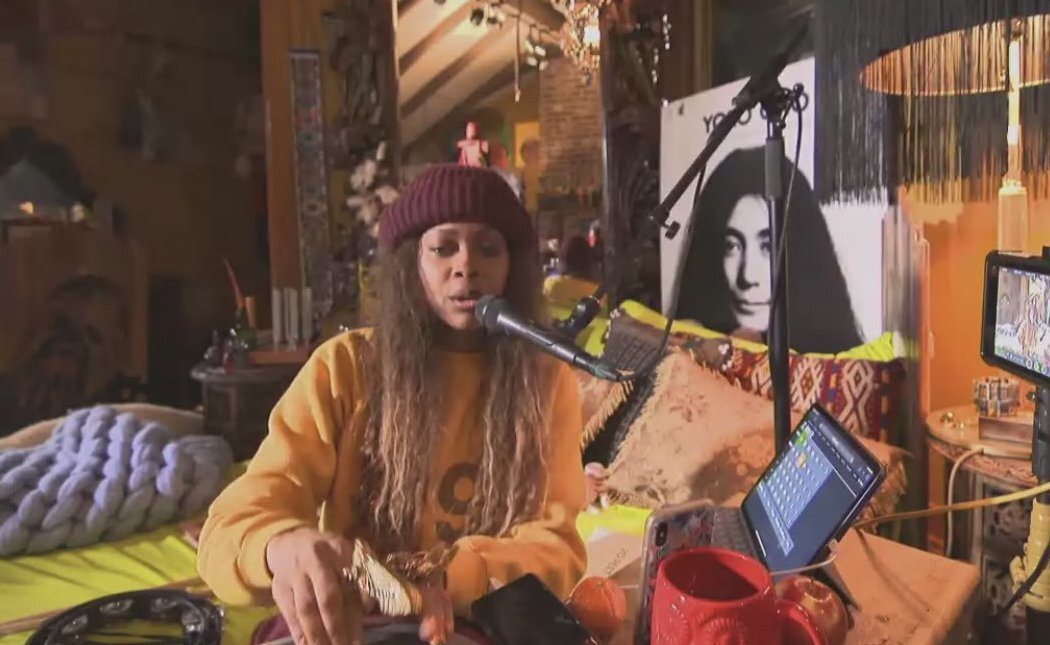Polyphonic Spree Releases a Souvenir of its Pre-Pandemic Plans

The Dallas-based symphonic pop band’s new album literally picks up where its 2020 left off.
Every band has a COVID story. The Polyphonic Spree recorded theirs. In March 2020, the Dallas-based pop maximalists were scheduled to play a covers show, and while some songs like The Monkees’ “Porpoise Song” and The Bee Gees’ “Run to Me” came easily since they had been part of the band’s live show for years, others were worked up or solidified for the occasion. While they prepared though, Spree leader Tim DeLaughter monitored the news to see what was happening with the then-new Coronavirus as each day brought previously unimaginable news. “Three hours before the show, we made the call not to play,” he says. “Between us and the venue, we came to the realization that it wasn’t a good idea to bring people in.”
No one knew then how contagious COVID-19 is or how it was transmitted, but DeLaughter thought it seemed like a waste just to let the preparation go like that. “We had already been together for a month and had been together the night before rehearsing these songs, so we were, like, Shit, we’ve got all this music and we’re ready to play,” he recalls. “Let’s go back and document it so that when we go to play it in the future whenever that is, we’ll have documentation of it.”
They went back to his home studio, hung the mics and recorded the songs essentially live in 10 hours. Now, a year later, Polyphonic Spree has released that night’s work for a new album titled Afflatus. In a lot of ways, it’s a trip down Memory Lane for DeLaughter, but it’s also true to the Polyphonic Spree.
The size of Polyphonic Spree added to the weight of the Coronavirus. DeLaughter took pride in his refusal to pare down the size of the 22-member band, even though touring with a band that large is economically brutal. What would a quarantine mean for all those people’s lives and bank accounts, and what would it mean for the band as a community? A band meeting would break rules about the size of a gathering, and unlike many bands, the Spree couldn’t do live-streamed shows from home. It would take a gym floor to socially distance the members from each other.
But that size has been the band’s calling card since 2002 when it emerged in long, white robes. DeLaughter’s hair fell in long, loose curls as he led a 22-member band complete with strings, horns and a small choir of women, and the combined look and the band’s Texas roots prompted the press, particularly the British press, to talk about the band as a new age cult. Today, DeLaughter’s amused by that, and even though he shot down that rumor in a 2002 story in The Guardian, he didn’t shoot it dead. He told writer Alexis Petridis, “I swear to God, I didn't think about it as a religious thing or a cult thing. Now, I go back to England and everybody's talking about it as being a cult. There again, 10 years from now, you may find out that we are a fuckin' cult.” He similarly left the door open in other interviews at the time.
Today he says the robes were a practical solution to a basic problem. “People always judge you by what you wear,” he says, and with so many people onstage, he wanted a coherent look that wouldn’t distract from the songs, which seemed impossible if the musicians were left to their own devices. “The robes made the most sense because it’s easier to manufacture something like that and you don’t have to worry about tailoring,” DeLaughter says. “It’s basically just a piece of fabric cloaking the body.” They were white because a psychedelic light show accompanied early Spree shows, and the lights were trained on the members in their robes. DeLaughter gave up the light show because the darkness necessary to make the lights dramatic also made it hard for the symphonic players to get their fingering right, but the robes remained for the first few years because they dispelled the distraction of street clothes.
It’s a sign of what the musical landscape looked like in 2002 that critics entertained the possibility that Polyphonic Spree might be a cult. In a year when the album charts were topped by The Eminem Show, Creed’s Weathered, Nellyville, Pink’s M!ssundaztood, and Linkin Park’s Hybrid Theory, people had a hard time imagining that musicians would play beautiful, uplifting music unless they had been David Koresh-ed. Others thought Polyphonic Spree had to be some kind of an elaborate act, but the truth was simpler than all that.
DeLaughter built the band around the sound he imagined for his “perfect band:” “Instead of one person singing, it would be 10 people singing. Instead of guitars and drums and bass, it would be strings and horns mixed with that. A spree of instrumentation and melody, all going at one time. The fascination was with creating a sound.” He admits he’s a fan of easy listening, beautiful music, and while that’s not what Polyphonic Spree is, you can see the family resemblance. He uses the instruments of symphonic music to play pop the way 1960s acts like The Hollyridge Strings did, not to shade in hints of classical music the way Electric Light Orchestra did in its early years.
Some of the roots of that sound are clear on Afflatus. “I was raised on the radio,” DeLaughter says, and he loved the sunny pop of The Association. Their luxurious 1967 hit “Never My Love,” with harmonies and cooed vocals that wrapped the lyric in satin, was a natural for the album, and it’s no surprise that the Beatle they cover is Paul with their version of “Let ‘Em In.” Beautiful music dominates the song list with The Bee Gees’ pre-Saturday Night Fever high school slow dance “Run to Me” and Barry Manilow’s grandly dramatic “Could it Be Magic.”
“I used to run my dad’s business on the weekends when I was young, and there was a Barry Manilow tape there,” DeLaughter recalls. “I loved the epic-ness of the schmaltzy pop songs that Barry did.”
Other choices come from different places in DeLaughter’s past. In a high school band, he played Rush’s “The Spirit of Radio” and decided that it would fun to adapt it for the Spree. He worried about his ability to hit Geddy Lee’s highest notes but thinks he got close enough. “A lot of Rush fans will disagree with me,” he says, and even though he does obvious reach for notes a time or two, DeLaughter found following Manilow’s vocals a bigger challenge. “You have to do a little falsetto with Geddy, but that register is kind of in my range,” DeLaughter says. He also tends to glide on to notes like Lee, so singing Rush felt comfortable. “Could It Be Magic” requires a more straightforward approach that comes less naturally to him. The extreme, deeply passionate yearning in Manilow’s performance drew him to the song, “but trying to put that across singing kinda straight was tough for me.”
Some choices are less well-known. The Spree turned to Their Satanic Majesties’ Request to find The Rolling Stones’ “She’s a Rainbow,” and they visit the ABBA songbook for “The Visitors,” even though it peaked at number 63 on the U.S. charts in 1982. They do Daniel Johnston’s “You Put My Love Out the Door” after DeLaughter sang it at an acoustic tribute to Johnston after he died in 2019, and they went to the last track of INXS’ Shabooh Shoobah for “Don’t Change,” a song they worked up to celebrate INXS for an Australian tour.
According to DeLaughter, the common thread between the songs is most were hits on the radio, most on AM radio. “People know those songs and they can sing to them,” he says. They certainly play to Polyphonic Spree’s musical strengths, but Afflatus also syncs up with the band’s concept. Part of the fun of the Spree live is the anarchic energy generated by a stageful of musicians, as well as the tangible spirit of community onstage. The songs—even the lesser known ones—are so immediate that fans can sing along by the second chorus, so they effectly invite fans to join the Spree. The versions are relatively faithful because DeLaughter’s not rethinking the songs. The goal isn’t to find new meanings or relevance in the lyrics but to share a moment with the audience. And as the Polyphonic Spree demonstrate, there’s magic when communities come together and sing.
The members of Polyphonic Spree recorded Afflatus early in the pandemic when it was easy to be bold because the reality of COVID-19 was hard to grasp. Talk of quarantines seemed so unlikely. How long was this going to go on? A week? A couple of weeks? During the night they recorded Afflatus, the Spree figured that if anyone had it, they all had it after all the rehearsal. None did at the time, but later in the year during one of the spikes, five members of the band were sick with COVID. Fortunately, the situation never got worse than that, and now they’re starting to work on a new album. DeLaughter has a concept for it, but he’s reluctant to elaborate since the songs tend to take on lives of their own in the studio. “You don’t really know if it’s better, but it is what it is,” he says. After years with Polyphonic Spree and the alternative rock band Tripping Daisy before that, he knows better than to try to force the music to follow a pre-determined path. “In my mind, I have an idea how I want this one to be, but at the end of the day I don’t know what the fuck it’s going to be.”
Creator of My Spilt Milk and its spin-off Christmas music website and podcast, TwelveSongsOfChristmas.com.






